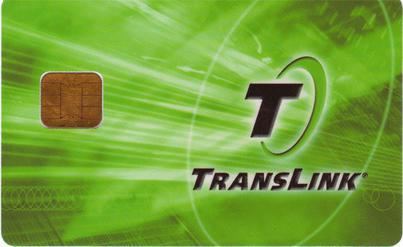Location San Francisco Bay Area | Launched 2010 | |
 | ||
Technology MIFARE DESFire (MF3ICD40) Operator Cubic Transportation Systems Manager Metropolitan Transportation Commission Currency USD ($300 maximum load) | ||
The Clipper card is a reloadable contactless smart card used for electronic transit fare payment in the San Francisco Bay Area. First introduced as TransLink in 2002 by the Metropolitan Transportation Commission (MTC) as a pilot program, it was rebranded in its current form on 16 June 2010.
Contents
History
In 1993, Bay Area Rapid Transit (BART) and County Connection launched a pilot program named Translink (not to be confused with other agencies with that name) that allowed the use of a single fare card between the two systems. The card, which used magnetic stripe technology, was envisioned to one day include all Bay Area transit agencies. However, due to technical problems, the program was abandoned two years later.
Translink had a projected capital cost of $4 million when undertaken in 1993. In its current form, first as TransLink and later as Clipper, implementation was expected to cost $30 million. Cost estimates have since increased; the projected 25-year capital and operations costs are now estimated at $338 million.
Scheduled implementation delays have added up to more than a decade. In 1998, MTC envisioned full availability of TransLink by 2001. However, it was fully operational for only five transit agencies by 2009. As of December 2011, Clipper was only accepted by eight of the Bay Area's transit agencies.
Clipper was developed by Australian-based ERG Group and Motorola under the ERG-Motorola alliance in April 1999. However, upon the launch of Clipper, Cubic Transportation Systems has taken over administration of distribution, customer service, and financial settlement of the program.
Full implementation of Clipper has been far slower than that of similar contactless smart cards, including the Oyster card and SmarTrip, chiefly due to bureaucratic difficulties.
On June 16, 2010, MTC changed the TransLink name to Clipper, an homage to the clipper ships of the 19th century, which were the fastest route for traveling from the east coast to San Francisco, and eliminated the contact interface which had been used to load funds onto the cards at Translink machines.
In October 2010, the MTC selected 路路通 (Pinyin: Lùlùtōng, "Go Everywhere Card") as the official Chinese name for Clipper.
Cost of card
Obtaining a card was free from introduction in June 2010 to encourage users to adopt the card, until September 1, 2012 when new adult cards began to cost $3. This charge covers the approximately $2 per card to manufacture and reduces the incentive to throw away the card if the value goes negative when fare is calculated on exit. The $3 fee is waived if the card is registered to auto-load more value (in which case it cannot go negative).
Adding money
Passengers can add money to their Clipper cards in person ("at participating retailers, participating transit agencies' ticket vending machines and ticket offices, Clipper Customer Service Centers, and Clipper Add Value Machines") at work, automatically, or online. While the money is added immediately in person, it will take 3–5 days before it registers on the Clipper card if added by telephone or online.
Transit agencies
Clipper is currently functional for seventeen Bay Area transit agencies:
In addition, a few parking garages in the Bay Area currently accept Clipper as payment.
A number of smaller regional transit agencies have not yet joined Clipper, including ACE, Rio Vista Delta Breeze, and Union City Transit.
Technology
Clipper utilizes a NXP Semiconductors MIFARE DESFire (MF3ICD40) integrated circuit to manufacture the card. The card operates on the 13.56 MHz range putting it into the Near Field Communication category (rather than RFID, as is commonly misconceived). Because the card uses NFC technology, any NFC-enabled device can read the serial number, travel history, and current balance on the card. However, data cannot be written to the card without the proper encryption key, preventing unauthorized access to funds on the card. The former Translink cards, while still functional on the fare system readers, do not conform to MIFARE and are unreadable by 13.56 MHz readers.
Because Clipper operates in multiple geographical areas with sporadic or non-existent internet access, the fare collection and verification technology needs to operate without any networking. To accomplish this, the Clipper card memory keeps track of balance on the card, fares paid, and trip history. Unfortunately, this also means if funds are added to the Clipper account via the internet, funds will not show up on the clipper card until it has been scanned at an internet-enabled (or recently synchronized) device. Buses and other vehicles without internet access will have to return to a service station in order to synchronize with Clipper's servers. During synchronization, the payment collection device will upload to the server data about any fares collected, and will download information about new account balances. Riders who scan their card at a recently synchronized payment collection device will have their card updated to reflect their true account balance.
The waiting period between synchronizations may cause some cards to report lower funds than are actually on the corresponding Clipper account. In order to alleviate this problem, Clipper allows riders to go as low as −$11.25 on the card before funds need to be added, and/or the card needs to be scanned at an internet-enabled or recently synchronized device.
